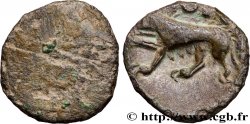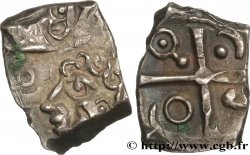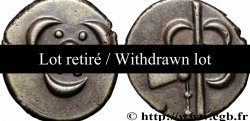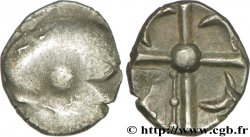v36_1249 - GALLIEN - SÜDWESTGALLIEN - SOTIATES (Region die Sos) Drachme trilobée, S. 367
MONNAIES 36 (2008)
Startpreis : 450.00 €
Schätzung : 600.00 €
Erzielter Preis : 450.00 €
Anzahl der Gebote : 1
Höchstgebot : 1 255.00 €
Startpreis : 450.00 €
Schätzung : 600.00 €
Erzielter Preis : 450.00 €
Anzahl der Gebote : 1
Höchstgebot : 1 255.00 €
Type : Drachme trilobée, S. 367
Datum: IIe siècle av. J.-C
Metall : Silber
Durchmesser : 16 mm
Stempelstellung : 12 h.
Gewicht : 3,43 g.
Seltenheitsgrad : R3
Kommentare zum Erhaltungszustand:
Monnaie frappée sur un flan large et ovale, avec la fleur un peu molle au droit mais un revers particulièrement net. Très agréable patine gris foncé, de collection ancienne
N° im Nachschlagewerk :
Pedigree :
Cette drachme est celle qui illustre le Savès, n° 367 ; aucune indication de provenance n’est signalée
Vorderseite
Titulatur der Vorderseite ANÉPIGRAPHE.
Beschreibung Vorderseite Fleur formée d’un globule central entouré de trois lunules.
Rückseite
Titulatur der Rückseite ANÉPIGRAPHE.
Beschreibung Rückseite Croix bouletée au centre, formée de quatre cantons, chacun ornés d’une lunule ; une hache à gauche au 3e canton.
Kommentare
Bien que G. Savès ne les signale pas, il existe au moins deux variantes pour ce type de drachme ; selon qu'il y a ou non des globules au revers devant la hache. Sur cet exemplaire, on devine un globule devant la hache, mais la particularité de cette monnaie réside surtout dans la forme de son flan. Les deux monnaies S. 366 et S. 367 (avec le flan arrondi) sont très différentes des monnaies habituelles S. 368 (avec le flan cisaillé).
Although G. Savès does not mention them, there are at least two variants for this type of drachma; depending on whether or not there are globules on the reverse in front of the axe. On this example, we can see a globule in front of the axe, but the particularity of this coin lies above all in the shape of its flan. The two coins S. 366 and S. 367 (with the rounded flan) are very different from the usual coins S. 368 (with the sheared flan)
Although G. Savès does not mention them, there are at least two variants for this type of drachma; depending on whether or not there are globules on the reverse in front of the axe. On this example, we can see a globule in front of the axe, but the particularity of this coin lies above all in the shape of its flan. The two coins S. 366 and S. 367 (with the rounded flan) are very different from the usual coins S. 368 (with the sheared flan)








 Berichten über einen Fehler
Berichten über einen Fehler Die Seite drucken
Die Seite drucken Teilen meiner Auswahl
Teilen meiner Auswahl Stellen Sie eine Frage
Stellen Sie eine Frage Einlieferung/Verkauf
Einlieferung/Verkauf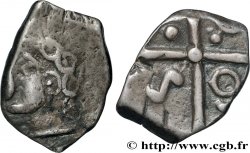
 Details
Details